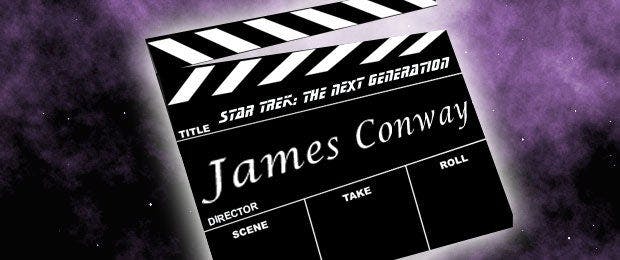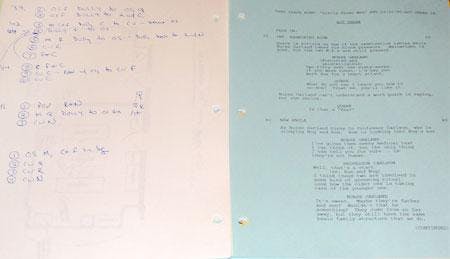Published Feb 16, 2012
Catching Up With Director James L. Conway, Part 1
Catching Up With Director James L. Conway, Part 1

James L. Conway holds the distinction of being one of the few directors to have called the shots on episodes of The Next Generation, Deep Space Nine, Voyager and Enterprise. Some of those episodes -- “Frame of Mind,” “Duet” “The Way of the Warrior,” “Death Wish,” “Broken Bow” and “In a Mirror Darkly” -- rank among the most well-regarded hours of their respective shows. Conway ultimately directed 18 episodes of Trek, but they’re just a drop in the bucket of a long and varied career that’s seen him direct the low-budget 80’s films Hangar 18 and The Boogens, produce and/or direct everything from The Life and Times of Grizzly Adams, Matt Houston and MacGyver to Charmed, Supernatural and Switched at Birth, and write the just-released novel Dead And Not So Buried. StarTrek.com recently caught up with Conway for an extensive interview in which he looked back at his many years directing Trek and talked about Dead And Not So Buried. Check out part one below and visit StarTrek.com again tomorrow to read part two.
How did you secure your first TNG direction assignment?
Conway: This was 1987, I think. I’d directed some MacGyver’s that previous year for Paramount and they were just launching TNG. They made me a deal to do two TNG episodes and a number of MacGyver episodes as part overall deal for that year. I came in and did “Justice” and then I did the season finale of the first season, “The Neutral Zone.” Though the producers knew we were picked up for a second season, nobody on the cast or crew knew we were picked up. Because it was the first syndicated show, there was no network, no UPN or CW or WB. They just went out and syndicated it themselves and it was an experiment to see whether it was going to work or not. So that was great fun. I look back at those early shows, and it’s remarkable how the franchise has changed from the first season of TNG to the last couple of episodes of Enterprise.
What do you remember about “Justice”?
Conway: The thing that struck me most was the first time I had a scene where they used a transporter. Nine people came down at once, believe it or not, so it was a huge wide shot. In those days, very early visual effects, when you had a lock-off, you had to take the camera and lock it down. You’d have wires attached to the camera, pinned into the ground to make sure the camera didn’t move at all. Nowadays you can take a handheld camera, zip it around, and put effects in later. So it was very primitive stuff. But we’d put the camera down and just the fun of having them say “Beam me up” for the first time was great. We shot that (episode) out in the Valley at a water reclamation plant. It was kind of a Japanese garden. We also shot in Huntingdon Park, at the Huntingdon Park library/art place in Pasadena, with beautiful rolling hills. Same thing; we had a bunch of people transport in and did a little action sequence there.
The first-season finale you mentioned was “The Neutral Zone.” You did one more TNG, which was “Frame of Mind,” in season six. Why so long between episodes?
Conway: At the same time I was directing the (different) Star Trek shows, I was also a writer and producer. I went off to do my own show, Paradise, a western with Lee Horsley. He played a gunslinger whose sister died, and he got her three kids. We did that for three seasons and when it finished I called Rick (Berman) and said, “I’m available again.” So I came back and did “Frame of Mind.” It was a great script because most of it, as we learned at the end, was in Jonathan Frakes’ imagination. He had this wonderful scene at the beginning where he went on for about a page and a half. It was just one shot where we started tight on him and then pulled back to reveal that he was sitting in this room surrounded by all these people staring at him. It was fun to come back to the show after so many years. By then it was an absolute great-running machine. The D.P. then was Jonathan West, who’d taken over from Marvin Rush, who’d gone over to do DS9. I worked with Jonathan and his crew on that show and then he ended up going over to Voyager and DS9. Then, for me, he did Charmed. I did Charmed for eight years and he and his crew did the last five years of it. It’s always nice when you meet people and stay with them for many years. Anyway, it was great fun to come back and work on TNG again.
You directed seven episodes of DS9, specifically “Duet,” “Necessary Evil,” “The Way of the Warrior,” “Little Green Men,” “Shattered Mirror,” “For the Cause” and “Apocalypse Rising.” Several of those are among the best-regarded DS9 hours. Let’s start with “Duet”…
Conway: That was a fantastic script and it was really dark. That’s the thing I loved about DS9; it didn’t have happy endings, everything wasn’t resolved at the end, and it was dark. The lighting was dark. The tone of it was dark. It was sort of an alternate universe in terms of Star Trek, and I loved that about it. It was really a fun show. That first script, making it was interesting because of the lead (guest) actor, Harris Yulin. He did a fantastic job. However, the makeup was three hours in morning and two hours at night and he had to get there at four in the morning. He was so tired that he had a very hard time remembering the lines, and we had a very hard time getting the performance. Then, it was one those performances where you don’t really know you have it until it’s cut together. He also didn’t like the ending. He got so invested in his character that he didn’t want his character to die at the end. He was trying to justify it and have him somehow survive, which almost never happens on a television show. The guest star never starts trying to change a script. He did, but mostly because he was so invested in the character. But it was one of those shows that, until it was edited, I didn’t realize how good it was.
“Way of the Warrior” must have been a crazy show to do. It was a two-hour episode. It was Klingon-heavy, and you had to introduce Worf (Michael Dorn)…
Conway: We didn’t really have any more time, but I had many more extras and it was a big action script. There were two or three really big set-piece action things. And we had to introduce Michael into the show. I really enjoyed doing that.
“Little Green Men” is a very entertaining, funny episode…

Conway: I loved “Little Green Men” for a couple of reasons. One, in my low-budget independent film days, I did a movie called Hangar 18, which is basically a version of “Little Green Men.” It’s the other side of it. Aliens had crash-landed and the government was hiding their spacecraft for that reason. It ended up that the government had to blow up the hangar and the people inside it. And “Little Green Men” was just a very funny telling of the Hangar 18 story. It was so clever and so much fun. I knew that they didn’t do much humor on DS9. When we sat down to do the tone meeting, Ira (Behr) said, “Are you sure you can get the humor here?” I said, “Ira, don’t worry about it. It’s going to be just fine.” And it was. He was very happy.
“Apocalypse Rising,” with the changeling impersonating Gowron, was your final DS9…
Conway: I was just doing that when I got the offer to come work at Spelling Entertainment. I’d written a pilot that didn’t sell and Duke Vincent called me and said he was thinking of throttling back a little bit, wanted to replace himself, and would I come in and be executive vice-president of the studio? I thought about it and decided to do that, and I did that for six years.
Visit StarTrek.com again to read the second half of our conversation with James Conway. To learn more about his book, Dead And Not So Buried, click HERE for his official site.

